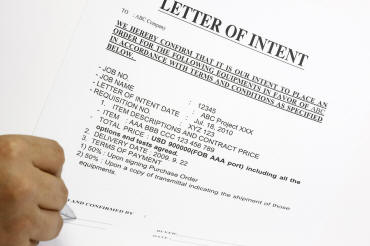In order to create a legally binding agreement, there must be offer and acceptance, contractual intention and consideration. The provisions of the contract must be certain. Otherwise, the innocent party will not be able to enforce a contract upon a breach of any of the terms and claim damages.
If any of the provisions in the contract are uncertain, then the agreement is not binding and cannot be enforced as contract. The court refers to such an agreement as a ‘Letter of Intent’.
However, sometimes a letter of intent is prepared intentionally to reflect the intentions of the parties should certain conditions to a transaction be satisfied. These situations may include pre-contractual negotiations in respect of quantity /quality of goods, services, pricing and time deadlines for delivery. The letter will normally state that it is a non-binding agreement until specific conditions are fulfilled.
Benefits of a Letter of Intent:
- The document states the intentions of the parties and makes their position clear as to future obligations. It can also provide protection in case a transaction fails during negotiation process
- It shows clearly what has been agreed and what requires further negotiations so that there is no misunderstanding as to what is undecided
- The letter will give good guidance as to when the transaction should be finalised and the time deadlines for any particular terms to be fulfilled especially where the agreement is spread over a long period of time
- In the event of dispute, a letter of intent can clarify the position of the parties and show that there was an intention to enter into a legally binding agreement
Drawbacks of a Letter of Intent
- Both parties may treat a letter of intent differently. One party may commit himself to fulfil the terms of the letter with intentions to finalising the contract, whilst the other party may simply treat this as merely a pre-negotiation document.
- Once the work is undertaken by both parties, their intention as to completing the contract may change. They may no longer want to be legally binding by any formal agreements, which may cause problem in the future if any of the terms is broken.
- Letters of intent can also put a limitation on negotiations with other professionals which can create further issues
It is still unclear why parties want to create such legally worthless document, if their intention is to form a legally binding contract. Sometimes it is due to the fact that the parties believe the agreement to be valid, only to discover, after costly litigation, that it was just an unenforceable and not legally binding letter of intent.
In essence, the letter of intent was traditionally regarded as a document with a very little legal meaning. However, the courts nowadays distinguish certain circumstances where parties are recognised to have the rights and obligations which makes the letter of intent legally binding. The court will look at:
- The facts of the case, wording and the circumstances at the times the letter was drafted
- Whether the terms in a letter of intent were certain
- Whether the letter was ‘subject to contract’. This term would normally indicate that the letter is not legally binding. However, if the parties undertake work in accordance with the terms of the letter of intent, the court may decide that they formed an implied contract by conduct which of course, will be binding
- The duration of the letter of intent. If the letter states the expiry date, it is presumed that the parties enter into a contact automatically.
- Each case need to be decided on its own merits
Conclusion
Although a letter of intent can be extremely helpful in commercial transactions and negotiations, it should not be considered as a substitution for a legally binding contract. It is crucial that the letter of intent is carefully drafted stating legal foundations such as terms and intentions of the parties clearly. Ideally, the letter of intent should be prepared by a professional who will ensure that all necessary requirements are met.
